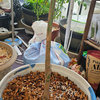re: Still confused as to grafted trees?
jean1976
18 years ago
Related Stories

GREEN BUILDINGLet’s Clear Up Some Confusion About Solar Panels
Different panel types do different things. If you want solar energy for your home, get the basics here first
Full Story
LANDSCAPE DESIGNSmall Garden? You Can Still Do Bamboo
Forget luck. Having bamboo that thrives on a wee plot just takes planning, picking the right variety, and keeping runners in check
Full Story
REMODELING GUIDES10 Signs You’re in the Middle of a Renovation
A renovation project allows you to choose every last detail for your home, but decision making can quickly go from ‘Ooooh’ to ‘Argh!’
Full Story
GARDENING AND LANDSCAPINGCrazy for Fruit Trees
Whether a single citrus or a mini apple orchard, even the smallest landscape space can bear deliriously delicious fruit
Full Story
EDIBLE GARDENSHow to Grow 10 Favorite Fruit Trees at Home
Plant a mini orchard in fall, winter or early spring to enjoy fresh-off-the-tree fruit the following year
Full Story
EDIBLE GARDENSHow to Add an Apple Tree to Your Edible Garden
Readily available, beautiful and fragrant, apple trees offer four-season interest along with crisp, juicy fruit
Full Story
FARM YOUR YARDIf You Have Room for Only One Fruit Tree ...
Juice up a small garden with one of these easier-care or worth-the-effort fruit trees for a mild climate
Full Story
GARDENING GUIDESHow to Keep Your Citrus Trees Well Fed and Healthy
Ripe for some citrus fertilizer know-how? This mini guide will help your lemon, orange and grapefruit trees flourish
Full Story
CONTEMPORARY HOMESHouzz Tour: A Heartfelt Home Amid the Trees
An architect helps his parents’ dreams come true by building them a ‘forever home’ connected to its valley views
Full Story
EDIBLE GARDENSHow to Grow Your Own European and Asian Pears
Try these trees for their good looks, delicious fruit and wide range of sizes — plus you can espalier them
Full StoryMore Discussions








billy1had
gardner_dragon
Related Professionals
Essex Landscape Architects & Landscape Designers · Glassmanor Landscape Architects & Landscape Designers · Horsham Landscape Architects & Landscape Designers · Wixom Landscape Architects & Landscape Designers · Arlington Landscape Contractors · Boca Raton Landscape Contractors · Brookline Landscape Contractors · Fairfield Landscape Contractors · Kahului Landscape Contractors · Middletown Landscape Contractors · Natick Landscape Contractors · Parkland Landscape Contractors · Paso Robles Landscape Contractors · West Coon Rapids Landscape Contractors · Shafter Landscape Contractorspecanman
rickjames